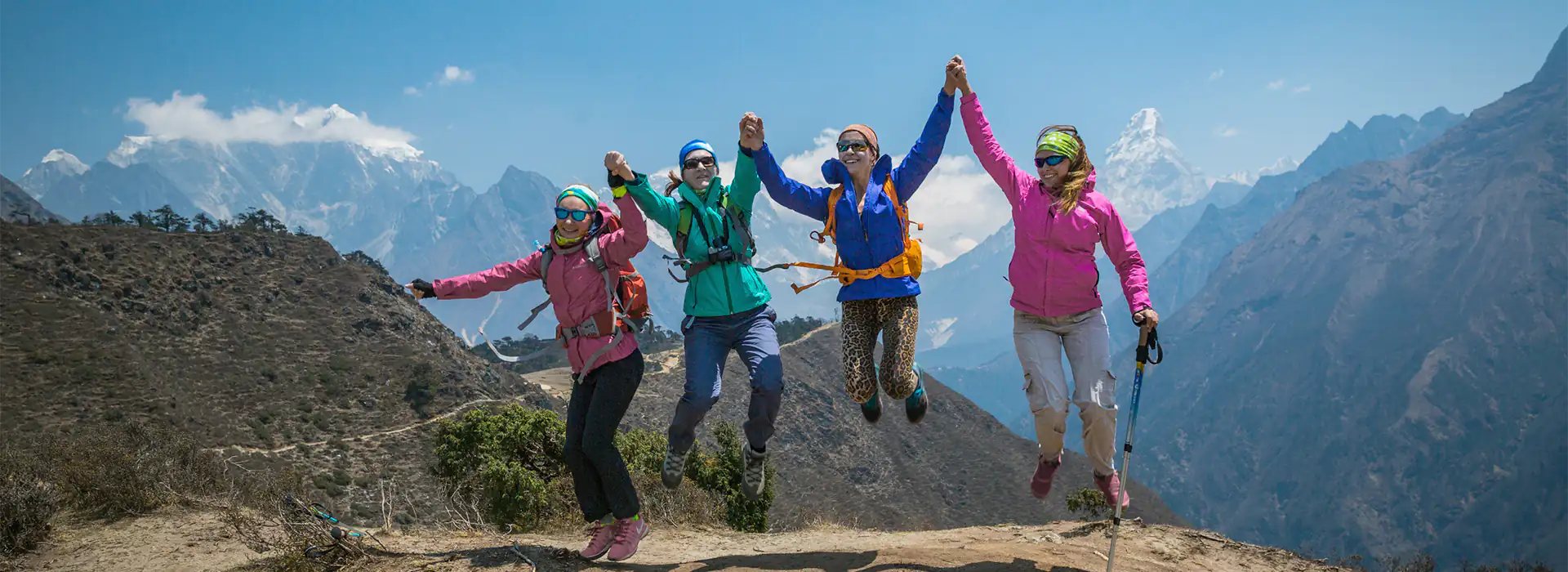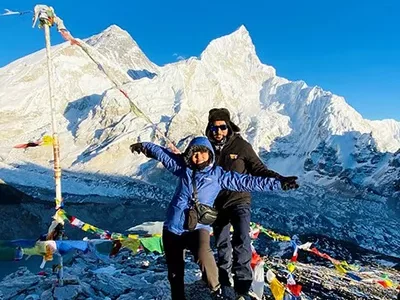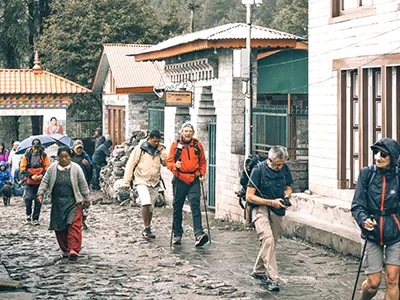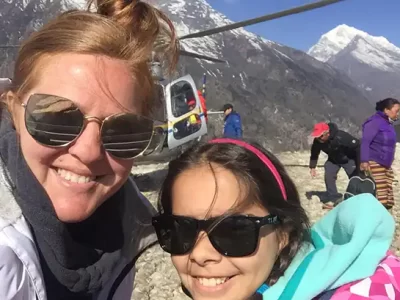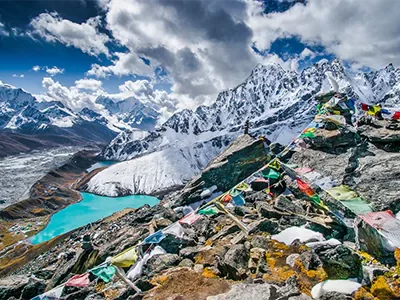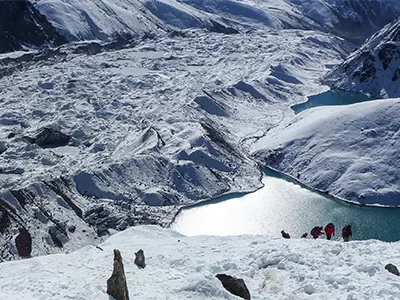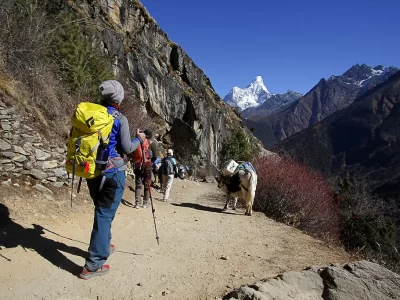Located in the Nepal Himalayas, the Everest Base Camp Trek is a well-traveled path that leads adventurers to the foot of Mount Everest. The hike is 130 kilometers long and takes about 12-14 days to finish. Trekkers choose to do Everest Base Camp Trek in May because this is less crowded than March and April, and the weather will be almost the same.
Stunning Himalayan vistas may be seen in typically stable and exact weather in May, making it an ideal time to begin the trip. But remember that May is the busiest month for hikers, so that the paths may be overcrowded with other hikers.
To begin the journey, you will fly to Lukla, a tiny town in the Solukhumbu area and the district’s official entry point to the Everest region. Following the path from Lukla, hikers will pass through the Sherpa settlements of Namche Bazaar, Tengboche, Dingboche, and Gorak Shep on their way to the base camp.
Views of snowy mountains, including Everest, Lhotse, Nuptse, and Ama Dablam, can be seen from the path as hikers make their way through rhododendron, pine, and rich juniper forests. The local Sherpa people are noted for their kindness and generosity, and they often welcome trekkers into their homes and Buddhist temples.
Acclimatization becomes increasingly essential for preventing altitude sickness as the altitude raises throughout the walk. One way to do this is to hike to higher elevations during the day and then return to a lower altitude before bed. The importance of taking the prescribed medicine and drinking enough water cannot be overstated.
The trip culminates at Everest Base Camp, at an elevation of 5,364 meters. The view from the base camp of Mount Everest is breathtaking, and it’s the closest that hikers can get to the summit without risking their lives.
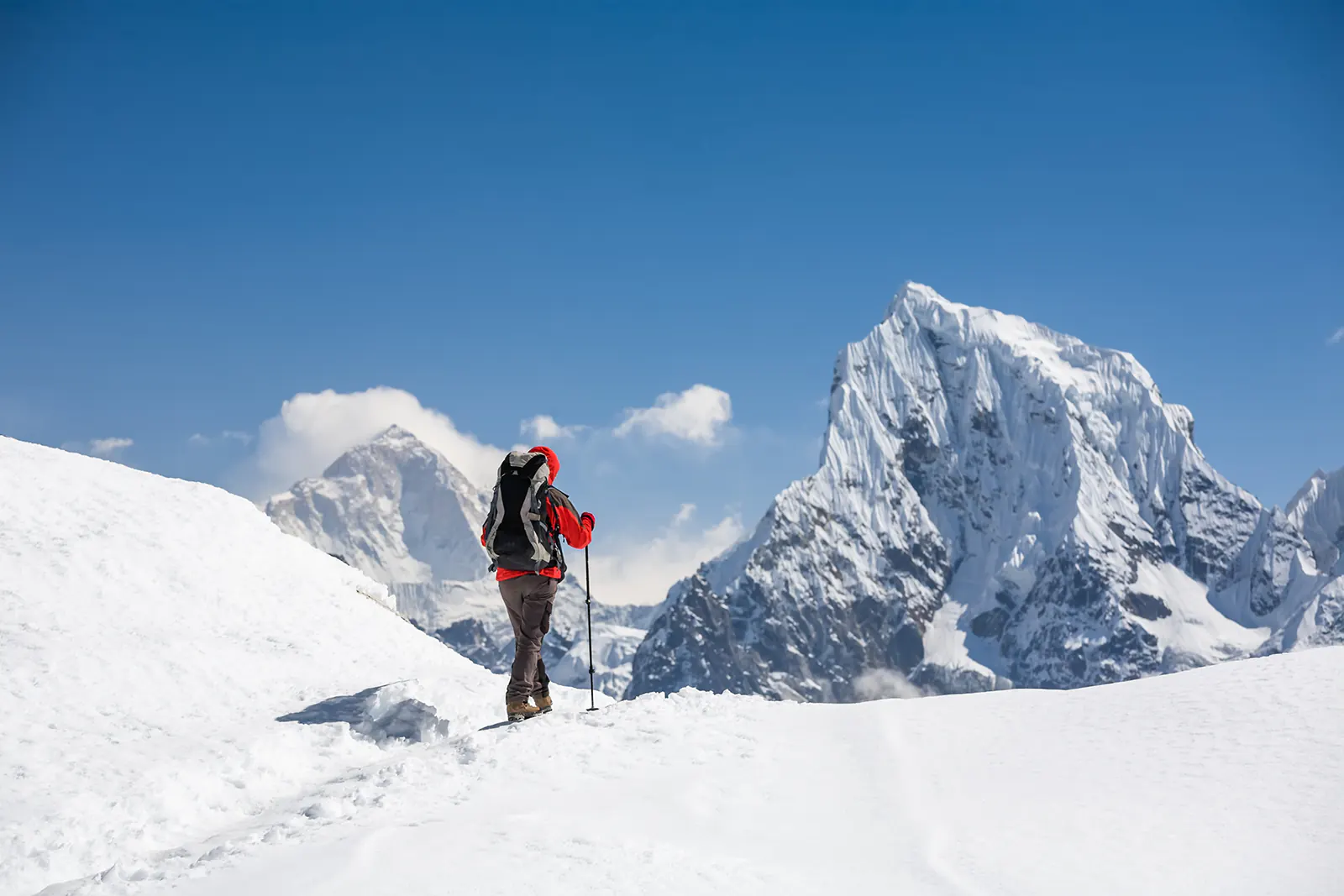
Everest Base Camp Temperature in May
Temperatures on Mount Everest in May vary widely depending on height and location. The average temperature at the base camp, which is located at an elevation of around 5,364 meters, is between -12°C and -18°C (10°F and 0°F), which is relatively cold.
Temperatures can dip to as low as -60°C (-76°F) at the peak of the mountain (8,848 meters), and sometimes much lower.
The weather and temperature on the mountain can vary quickly and unexpectedly, so it’s best to come prepared for a wide range of possibilities. Keep yourself warm and dry by wearing high-quality layers, a down jacket, and waterproof footwear.
The weather at Everest Base Camp in May
The weather is generally believed to be steady and clear in May at the Everest Base Camp, making it a popular period for trekking. Temperatures range from 5 to 15 degrees Celsius (41 to 59 degrees Fahrenheit) during the day but can dip to as low as -12 degrees Celsius (14 degrees Fahrenheit) at night.
But remember, weather in the highlands is notoriously fickle and prone to sudden shifts. It’s crucial to be ready for a broad range of weather conditions, including strong winds, snowfall, and reduced visibility, especially at higher elevations, and to have the right clothes and equipment. Pay attention to your guide’s recommendations and be flexible enough to change your schedule if the weather demands it.
Generally speaking, May is an excellent time to make the journey, but you should still be ready for the risk of bad weather by packing appropriately and carrying adequate supplies to keep you warm and dry.
Everest Base Camp Trek
Luxury Everest Base Camp Trek
Everest Base Camp Trek with Helicopter Return
How cold is Everest Base Camp in May?
Usually, the weather and temperature at Everest Base Camp may swing widely. From base camp, the typical daily temperature in May is 10-15 degrees Celsius (50-59 degrees Fahrenheit). However, the nighttime lows may be rather cold, typically hovering around the -5 to -10 degree Celsius mark (23-14 degrees Fahrenheit). It will help if you pack warm clothes and a high-quality sleeping bag in case you get cold while camping.
It’s also essential to remember that altitude and weather may significantly impact the temperature. At higher altitudes or during storms, it is not unusual for temperatures to fall even farther below freezing. Remember that the temperature might drop suddenly and unexpectedly, so it’s best to be ready for everything and bring appropriate clothing and gear.
You should also remember that the wind chill can make the already frigid temperatures feel even worse if you are out in the open during your hike. Protect yourself from the wind by wearing a windproof jacket and pants.
Finally, remember that chilly weather may exacerbate altitude sickness, so it’s wise to know the warning signals and be ready to get back down if required.
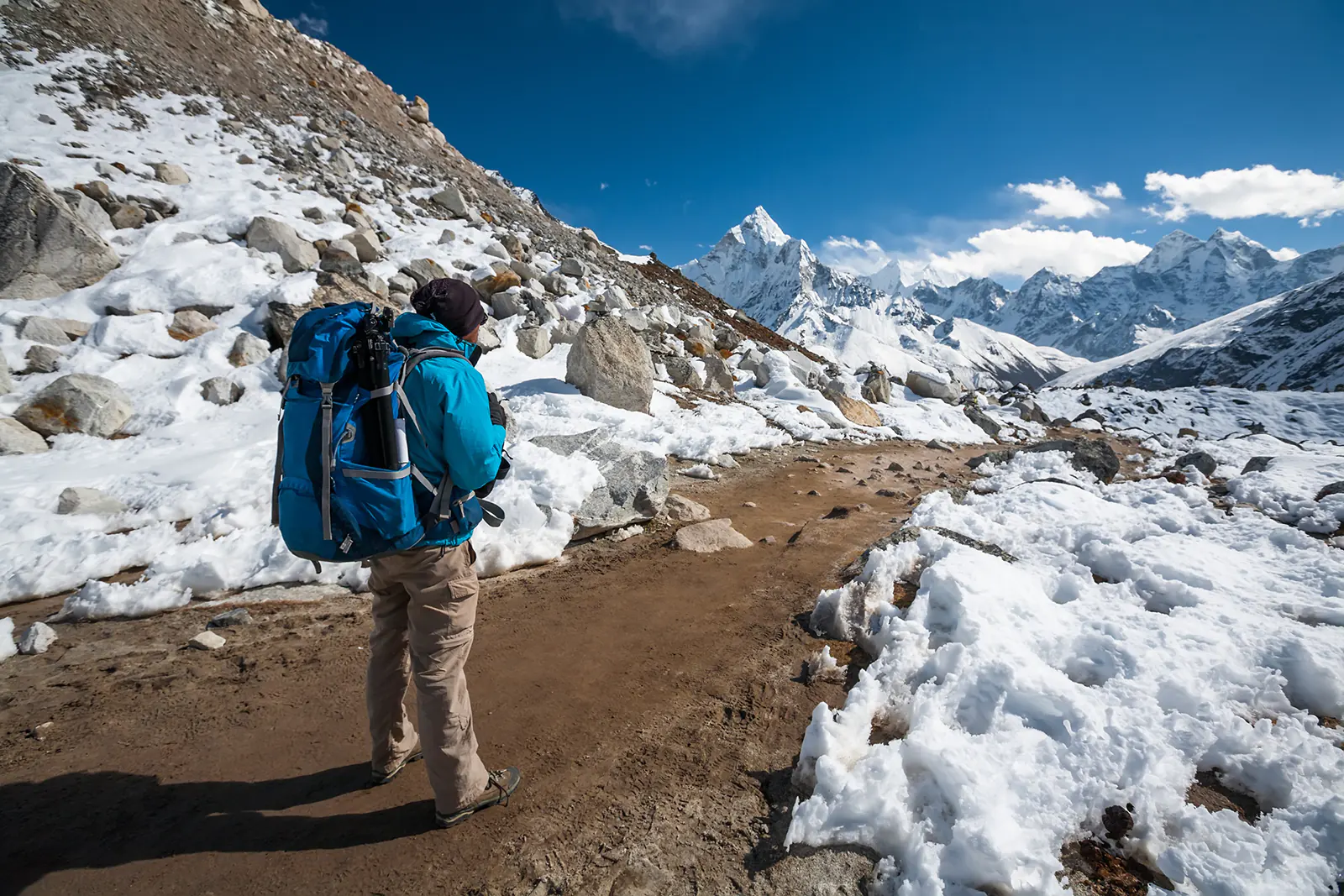
Why May is better than March and April
There are several reasons why May is favored over March and April for Everest Base Camp treks:
Weather: Compared to March and April, the weather in May is generally more consistent and clear. When the days are warmer, and there is less danger of precipitation (rain or snow), hiking over the mountains may be more enjoyable and the scenery more spectacular.
Trekking Trail: Snowmelt can leave the paths muddy and treacherous in March and April, making the hike more challenging and less pleasurable than usual. The paths are usually drier in May, making the hike more pleasant.
Mountain View: Views of the surrounding mountains are often more apparent in May than in March or April.
Time Duration: Getting used to the higher altitude is essential to avoid altitude sickness on the journey to base camp. Therefore acclimatization is a must. The trip typically takes between 10 and 12 days in May, giving you more time to acclimate than if you were to do in the colder months of March or April.
Best Season: May is the busiest month for Everest area hikers, so expect the paths to be congested with fellow adventurers. While the path may not be as well maintained as in other months, hikers are typically more prepared for the journey, and the weather is milder than in those months.
Remember that mountain weather is notoriously fickle and prone to sudden shifts. Hence, it’s crucial to pack for various circumstances and bring sturdy footwear, warm layers, and a sturdy rain jacket. Pay attention to your guide’s recommendations and be flexible enough to change your schedule if the weather demands it.
The disadvantage of Everest Base Camp in May
There are benefits to climbing Everest Base Camp in May and possible risks.
- The availability of lodgings and the associated costs may increase as the number of hikers on the path grows. Because of this, the trip may become more costly and less convenient.
- Increasing the number of hikers on the trail might hurt the ecosystem. There will be more pollution, garbage, and people using limited resources like water and firewood.
- Having more hikers in an area raises the likelihood of an accident or emergency, which in turn can cause rescue and evacuation times to lengthen. You must have adequate insurance and choose a dependable trekking service.
- The hike to base camp is strenuous and requires excessive stamina. More hikers mean more congestion on the trail and a greater danger of injury.
- Be aware of these inconveniences and ready for the likelihood of crowds and other difficulties while arranging your journey. Selecting a reliable trekking organization, packing appropriately, and carrying sufficient travel insurance and emergency evacuation coverage is also crucial.
Daily life on the trail to Everest Base Camp
Everest Base Camp Trek in May would begin with an early rise, breakfast, and the start of the day’s climb. Typically, the path passes through picturesque mountain scenery and quaint, traditional Sherpa communities. Trekkers can enjoy breathtaking vistas of Everest and other Himalayan peaks along the route. On most hikes, lunch is eaten in a teahouse or at a designated rest area. Usually, hikes conclude by early afternoon, giving you time to relax, eat, and get ready for the next day. Cultural activities, such as going to a Sherpa’s house or monastery, may be included on certain days.
Gokyo Cho La Pass Trek
Gokyo Lakes Trek
Everest Base Camp Short Trek
Tips for trekking Everest Base Camp in May
- May is a busy month for tourists, so plan your excursion.
- Prepare for your trip by stocking up on warm clothes, hiking boots, a sleeping bag, and a sturdy backpack.
- Get in shape and prepare for an arduous journey since it will require much trekking on rough, rocky terrain and high altitude.
- If you are concerned about altitude sickness or other medical emergencies, be sure you have travel insurance, including emergency evacuation.
- You’ll want to book a trip to Kathmandu, from whence you may get a domestic aircraft to Lukla, the trek’s official beginning point.
- If you’d like assistance finding your way and carrying your belongings, you may hire a guide or porter.
- You’ll need to obtain the appropriate permissions to visit a national park.
- You may alter your schedule based on the information you get as you plan, like the weather and the state of the trails.
- Have fun, be prepared to roll with the punches, and, most importantly, respect the local culture and environment.
Hidden Facts of Everest Base Camp Trek
- In 1953, Sir Edmund Hillary of New Zealand and Tenzing Norgay of Nepal made history by completing the first known ascent of Mount Everest.
- Mount Everest’s base camp is at an impressive 5364m above sea level (17,598ft)
- Culturally rich experiences may be had in the various Buddhist monasteries and traditional Sherpa communities along the route to Everest Base Camp.
- On the way to Everest Base Camp in May, you’ll travel through Sagarmatha National Park, a UNESCO World Heritage Site home to various plants and animals, including the critically endangered snow leopard.
- Although the path to base camp does not include any technical climbing or mountaineering skills, it does demand a high degree of physical condition.
- The only way to get to base camp is on foot or by helicopter, as the path is inaccessible by car.
- Stable weather makes the months of September through November and March through May ideal for making the journey to base camp.
- You can make the journey to base camp on your own, but hiring a guide or a porter will make the journey much more accessible.
- The route through stunning alpine scenery and into the heart of Sherpa culture is half the appeal of the climb to base camp.
- The journey to base camp is not just for the daring but also those curious about the Himalayas and the Sherpa living there.
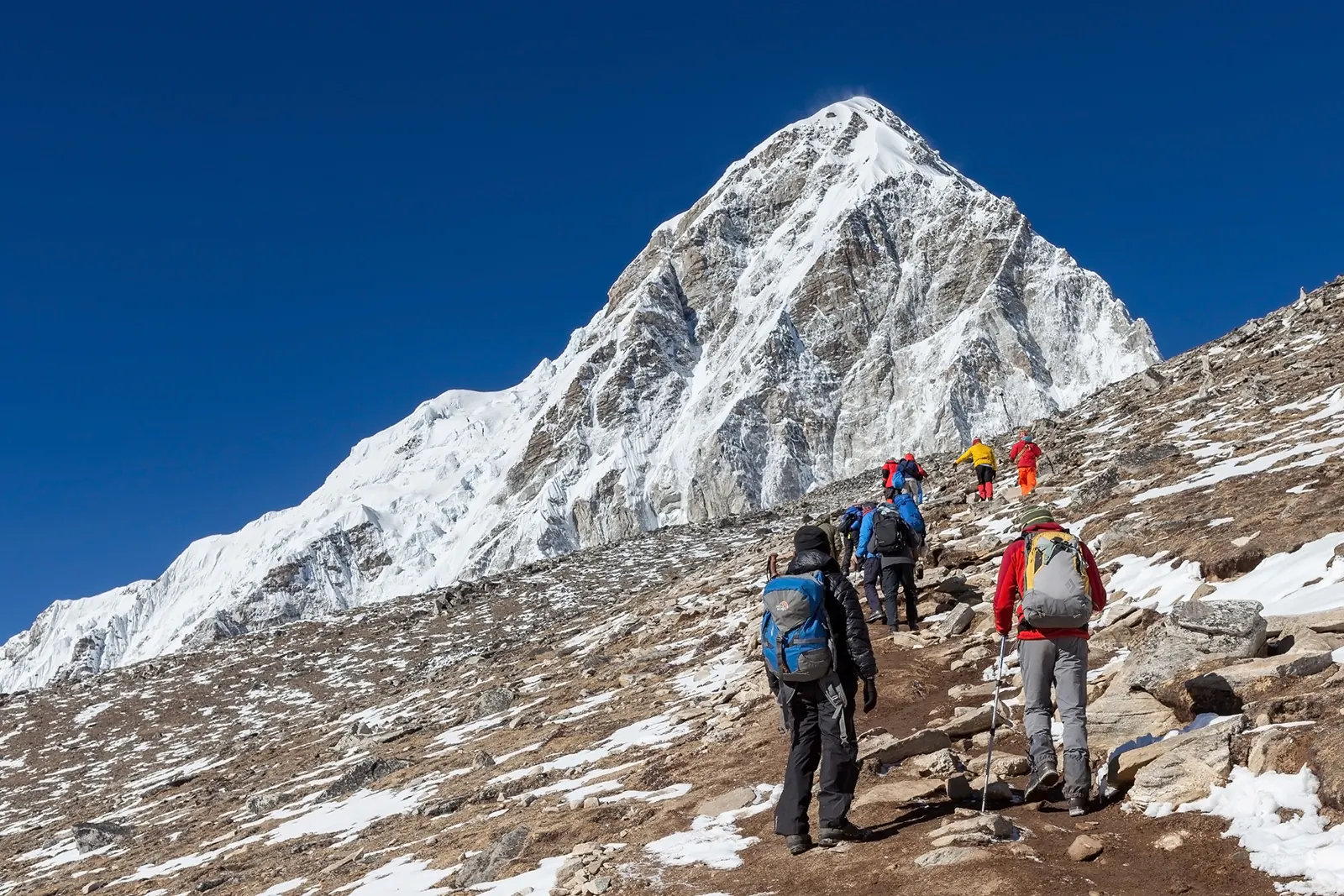
For what reasons should we pick Everest over Annapurna?
Numerous factors favor a hike to Everest Base Camp over Annapurna Base Camp:
- The vista from the base camp of Mount Everest – the tallest mountain in the world, is iconic.
- The trip to Mount Everest Base Camp offers a fascinating cultural experience as it winds past traditional Sherpa communities and Buddhist temples.
- A significant test of stamina and endurance, the hike to Mount Everest Base Camp is regarded as more complex than the hike to Annapurna Base Camp.
- Incredible Vistas: Hiking to Everest Base Camp is a once-in-a-lifetime opportunity to take in breathtaking views of the world’s tallest mountain and other Himalayan peaks.
- Achieving the base camp of the world’s tallest peak is a remarkable and once-in-a-lifetime opportunity.
- The path to Annapurna Base Camp is less strenuous than Everest Base Camp’s, offering stunning scenery and cultural experiences.
Both treks have advantages and disadvantages, so choosing one over the other depends on your preferences and what you hope to gain from experience. Annapurna and Everest Base Camp hikes provide excellent opportunities to see the stunning Himalayas and learn about the local culture.
How to make shorter Everest Base Camp Trek
- Everest Base Camp Trek in May is a grueling ordeal that takes about 12-14 days to complete. Here are a few ways to cut down on your travel time:
- Instead of beginning the walk at Jiri, you may take a short flight to Lukla, where the journey begins. You can shorten your hike by several days thanks to this.
- Instead of spending days on foot to get to base camp, you may take a quick helicopter trip. The downside is that you’ll have to spend a lot of money and miss out on the stunning scenery that can be seen along the trail.
- Skip rest days or reduce the distance traveled daily to condense the schedule. It’s vital to remember that acclimatization is required to avoid altitude sickness, and cutting the schedule too much can be dangerous.
- Refrain from visiting Kalapatthar: Kalapatthar is a great place to see the dawn or sunset, and it is also a well-known vantage point for a panoramic view of Mt. Everest. However, it is optional to see the mountain if you are on a tight schedule.
- Although these alternatives may reduce travel time, they also present certain dangers. Think about your level of fitness and expertise, talk to a local outfitter or guide, and then make any plans.
Tips for extending Everest Base Camp Trek
- A trip to Everest Base Camp usually lasts between 12 and 14 days, but there are several options to maximize your stay in the Everest region by extending your trek.
- Gokyo Lakes: The Gokyo Lakes is a worthwhile detour, as they are situated in the high Himalayas and provide breathtaking panoramas of Mount Everest. It may take up to 4 more days for this extension to go through.
- Island Peak is a famous hiking peak in the Everest area and may be climbed as a side excursion. It may take seven more days for this extension to take effect.
- Instead of returning to Lukla from base camp, you can continue on the Three Passes Trek, which takes you over Renjo La Pass, Cho La Pass, and Kongma La Pass. It adds around two or three days to the typical schedule.
- One of the largest and most significant Buddhist monasteries in the Khumbu region is the Tengboche Monastery, which may be visited as part of your itinerary.
- Remember that each option will increase the trek’s physical difficulty and time, so think carefully about your fitness level and previous hiking experience before committing to one. In addition to the trail’s current state, you should consider the weather prediction and the guide’s availability in making your choice.
Conclusion,
Everest Base Camp Trek in May is a once-in-a-lifetime adventure that provides visitors with a glimpse into the rich cultural history of the Sherpa people and the awe-inspiring Himalayan landscape. It’s a challenging hike that will test your fitness, but the benefits are well worth it if you’re up to the task.
The hike itself is not technically challenging, so you don’t need any prior climbing expertise, but you will need to be in good physical shape and prepared for long days on the trail. It’s also crucial to have enough travel insurance and emergency evacuation coverage and to hire a trustworthy trekking organization.
The proper clothing and equipment to keep you warm and dry are essential. You’ll need a high-quality sleeping bag, waterproof boots, a warm base layer, and a down coat. Especially if you’ll be traveling to higher elevations, pack for the likelihood of snow and chilly weather.
In sum, the Everest Base Camp Trek is a once-in-a-lifetime adventure that gives adventurers a glimpse into the rich cultural history of the Sherpa people and a chance to marvel at the breathtaking natural scenery of the Himalayas. It’s a challenging hike that will test your fitness, but the benefits are well worth it if you’re up to the task. You can make the walk an unforgettable experience by putting in the time and effort to prepare for it.
